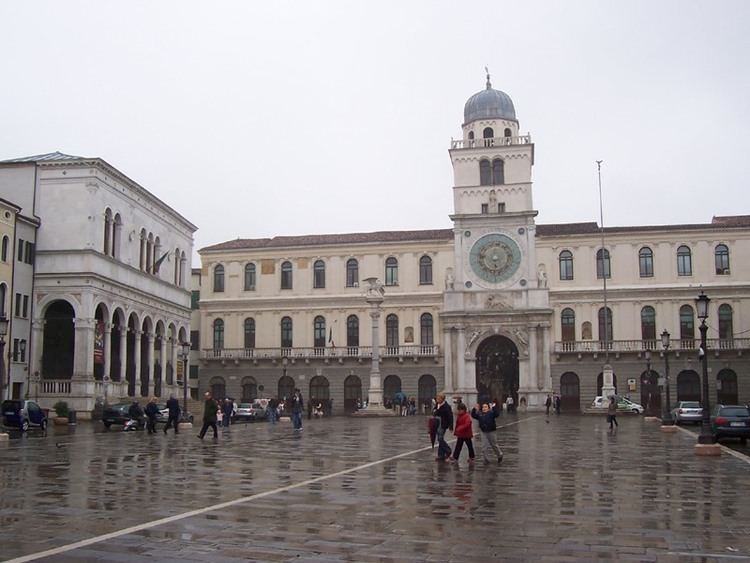 | ||
Address Piazza dei Signori, 35139 Padova PD, Italy Hours Open today · Open 24 hoursFridayOpen 24 hoursSaturdayOpen 24 hoursSundayOpen 24 hoursMondayOpen 24 hoursTuesdayOpen 24 hoursWednesdayOpen 24 hoursThursdayOpen 24 hoursSuggest an edit Similar Piazza della Frutta, Prato della Valle, Palazzo della Ragione, Pedrocchi Café, Church of the Eremitani | ||
Piazza dei signori padua italy
Piazza dei Signori is a city square in Padua, Italy.
Contents
'Concerns over the beautiful square, which is called the Signoria. This has stone floor cooked, serves for the theater of public shows of rides, and tournaments and is surrounded by towering factories and beautiful houses" (Angelo Portenari, Of Happiness of Padua, 1623)
Piazza dei Signori and Piazza della Signoria is one of the many plazas of the historic city of Padua. It was for centuries the scene of civic celebrations, tournaments and space representation of the city compared to larger squares of herbs (erbe) and fruits (frutta) that had more commercial leanings. The square is dominated by the famous Clock Tower.
History
The square was born in the fourteenth century with the demolition of an old district that stretched in front of the church of San Clemente, the result of urban design, promoted by Ubertino from Carrara. The square was designed to give importance to the tower and access to Palace on the east side, that he was building. It became the scene of tournaments and courtship. According to tradition it was the "gentlemen" Carrara that the square took its name.
The war between the Carraresi and the Visconti, fourteenth century, damaged the square and the buildings and is called the period "of Desolation". In the 14th century, the Venetians restored the square to be the fifth main civic area: for tournament play, the rides, the battles, the courtship, concerts and music festivals. Initially known as the "Square of Triumphs" and again "Piazza della Signoria". At parties for the patrons and official visitors the area was designed with the ephemeral architecture. On Shrove Tuesday a bull hunt was held. July 17 was the celebration to commemorate the reconquest of Padua in 1509. Father Alexander Gavazzi, May 9, 1848, renamed the square, "Piazza Pius IX", as part of the popular anti Austrian movement. It became "Piazza Unità d'Italy" after unification (1870) and then returned to the original name in the fascist era.
In ancient times the square was paved with brick laid in a herringbone pattern, this was replaced in the eighteenth century by slabs of Euganean trachyte. At the entrance to the square (now Via Nazario Sauro) there was a monumental well, until 1785. It was adorned with marble columns and cannonballs. The well was sealed in 1785 as being unsightly. The real was then used to refine the well of Piazza delle Erbe, the rest was all sold with gain of 50 ducats.The square hosts the morning city market.
Description
The square is rectangular. With houses all around it. While the houses are from various time periods, the arcades are fourteenth and fifteenth centuries. Some still bear decorations medieval and Renaissance.
At the west end, it is dominated by the Clock Tower, flanked by symmetrical buildings of Capitanio and Camerlenghi, buildings from the sixteenth and seventeenth centuries in mannerist style. Two niches, hold the busts of Saint Prosdocimus and St. Anthony. Both are of Nanto stone and were walled up during the anticlerical period of the Napoleonic occupation. They were restored in the 1990s.
On the square to the left column Marciana (mid-eighteenth century,) is a monument composed of pieces from the church of San Marco. This includes the marble column and capital of the Roman era. which were found in 1764. The lion is the work (1870) Christmas Sanavio to replace the one destroyed by French troops in 1797. The flag flagpole has a marble base dating back to the sixteenth century with decorations in high relief. The marble panels on all four sides represent the cardinal virtues. It has stood here from the second half of the eighteenth century.
To the east is the ancient church of San Clemente flanked by medieval houses. On the right it is placed a plaque commemorating the "serious and heinous crime committed by several cops", that occurred on Feb. 15, 1722 against university students; the culprits were "condemned to the gallows of the gallows, the jail and the dark prison" as it reported in the slab.
